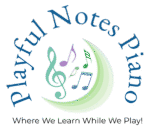In the world of early childhood piano education, keeping young learners engaged and focused can be a challenge. One effective strategy that has proven invaluable for me is incorporating movement in piano lessons. By integrating physical activity, we not only make lessons more enjoyable but also foster a deeper understanding of musical concepts. Incorporating movement in piano lessons is one of the best ways to engage children and make music come alive.

🥁 Feeling the Beat: Marching and Movement
Children naturally respond to rhythm and movement. By encouraging students to march to the beat of a song—whether it’s a piece played live or a recording—we help them internalize the pulse of the music. A lot of times I will play their assigned song for them first while they march or rock foot-to-foot to the beat–it almost always helps them feel the pulse of the music when it’s their turn to play. This practice of movement in piano lessons allows students to physically experience the rhythm, making abstract concepts more tangible.
Marching and other movement activities serve multiple purposes:
- Enhancing Rhythm Awareness: Physical movement reinforces the steady beat, aiding in the development of timing and coordination.
- Promoting Expressiveness: Moving to music encourages students to express themselves, fostering a deeper emotional connection to the pieces they play.
- Channeling Energy: Incorporating movement in piano lessons provides an outlet for young learners’ natural energy, helping them focus better during seated activities.
These reason (and more!) are why movement in piano lessons has become a cornerstone of modern, playful teaching methods.
👏 Body Percussion: A Hands-On Approach to Learning
Traditional clapping exercises are a staple in music education, but adding variety can enhance engagement. By introducing body percussion—such as tapping laps for bass clef notes and patting chests for treble clef notes—we create a multisensory learning experience. This method of movement in piano lessons not only reinforces rhythmic patterns but also aids in memorization and coordination.
Research supports the benefits of body percussion in music education. According to a study on body percussion activities, these exercises sharpen rhythm, stimulate creativity, and enrich the musical journey in ways that extend beyond the beats they produce. Even better, incorporating body percussion into music class helps to enhance the brains ability to plan ahead.
🚀 Movement Breaks: Enhancing Focus and Learning
Young children, especially those in pre-kindergarten and kindergarten, often have limited attention spans. Incorporating short movement breaks during piano lessons can significantly improve their ability to concentrate. These breaks, which might include stretches, simple dances or rhythmic games, serve as a reset, allowing students to return to the piano with renewed focus.
Moreover, movement in piano lessons isn’t just about physical activity; it’s a powerful educational tool. Engaging in movement helps children develop a sense of timing and coordination, essential skills for musical proficiency.
🌟 Integrating Movement Seamlessly
Incorporating movement in piano lessons doesn’t require elaborate setups. Simple activities can make a significant impact:
- Rhythmic Walking: Encourage students to walk in time with the music, adjusting their pace to match different tempos.
- Instrumental Movement: Use scarves or ribbons to have students interpret the music’s dynamics and phrasing through movement.
- Interactive Games: Implement games that combine musical concepts with physical actions, reinforcing learning through play.
These strategies not only make lessons more engaging but also cater to various learning styles, ensuring that each student can connect with the material effectively. I am all about meeting my kids where they are and adapting my lessons to their learning styles (as much as possible without losing the integrity of the lesson). Some students need more movement than others and I have a wide variety of activities that move us on and off the piano bench to keep restlessness away.
💛 Conclusion
The integration of movement in piano lessons offers a multifaceted approach to music education. By engaging the body alongside the mind, we create a holistic learning environment that nurtures rhythm, coordination, and a lifelong love for music. As educators, embracing movement in our teaching methods can transform the piano lesson experience, making it more dynamic and effective for our young learners.
The integration of movement in piano lessons offers a multifaceted approach to music education. By engaging the body alongside the mind, we create a holistic learning environment that nurtures rhythm, coordination, and a lifelong love for music.
If you’re looking for a piano teacher in Huntsville, AL who knows how to incorporate movement in piano lessons to channel restless energy into joyful, focused learning — Hi! I’m Ms. Sara! 👋 I’d love to welcome your child into my studio, where movement, music, and fun go hand in hand.

